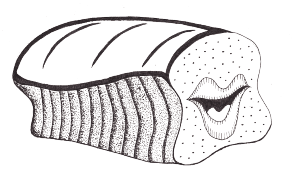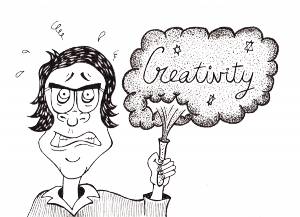Prof. Rena Balzan (Department of Physiology and Biochemistry, Faculty of Medicine & Surgery, University of Malta) stands out as one of the first women in Malta to carve out a scientific research career. She is also the author of numerous poems and novels in Maltese. Research colleague Dr Gianluca Farrugia delves into her backstory underlying her lifelong pursuit of both Maltese literature and science, which includes research on the anti-cancer properties of aspirin using Baker’s Yeast. Illustrations by NO MAD.
I gently knock on the door. Professor Balzan knows it is me. ‘Idħol (Come in), Gianluca’.
I open the door and drift into the office, settling down into my usual visitor’s seat by the enormous desk as Balzan remains glued to her computer, adding final touches to a document or email. I throw a cursory glance at the pristine office, the very same room I have stepped into countless times since I first started my Ph.D. under Balzanʼs tutorship eight years ago. Precious little has changed since then—the tall oak shelves, packed with their colourful mosaic of science textbooks, journals, folders, and dissertations (my own now included) still lean on the walls around the desk, accompanied by cabinets filled with years-worth of scientific papers. Several old calendars animate the room with colourful depictions of artworks, photos, and the odd cartoon, such as one portrait of Charlie Chaplin hard at work on a Sudoku puzzle (easily my favourite). Add to that a motley collection of no less than six small clocks, the signatory tea kettle, and you have a room bearing the distinctive marks of a very interesting character.
Balzan easily fits that description, given her unique contribution to both science and Maltese literature. She is a well-published researcher of molecular biology and biochemistry, but has also penned numerous poems, short stories and four novels in Maltese, some studied as part of the national curriculum. Balzan is both an artist and a scientist—a seemingly dissonant combination, which always intrigued me as a scientist and which I am very keen to discuss with her as she turns towards me, over her large mug of tea.
 In science we trust
In science we trust
Balzan explains how it all started, ‘I happened to discover the joy of reading at quite an early age, when I was about ten years old and this instilled in me an attraction for books that kept growing throughout my life. It was through reading that I became acquainted with the marvel of science and its ramifications. So when at grammar school we had to choose certain subjects for further studies, even though in the early sixties science subjects were not the favourite choice for girls, I opted for physics, chemistry, and biology.’
Balzan then read for a pharmacy undergraduate course at the University of Malta, a difficult choice given the then-prevalent mentality that a woman’s role was constrained to marriage, raising children, and managing household chores. She overcame this challenge in part thanks to family support. ‘I thank God that my father was a very progressive and open-minded person and my mother always co-operated with him. They rebuffed the comments from some people in my village, who should have known better, that a girl doesn’t need to go to university to further her studies, that this would be a waste of money and effort. In those days we paid quite hefty university fees.’
“Science is an ever-youthful topic. It knows no ageing, and a scientist is always aware that there is so much to learn. One never knows enough.”
Balzan then graduated, but had not seriously considered a career in scientific research until unearthing a copy of The Double Helix, James Watson’s famous account of the discovery of DNA. The book helped spark her interest in genetics and this resulted in her travelling to Milan to start out in research. ‘It was during my specialisation in Applied Genetics at the State University of Milan that I realised that a career in scientific research was the profession that attracted me most. Then with the boom in molecular biology and biotechnology starting in the eighties, my fate was sealed. It seemed it was all I had always wanted.’ After many years working with Balzan I can see that her love of science is as fervent as it was when she first started her career, drawn as she is to its demand for creativity, innovation, and inexhaustible challenges. ‘Science is an ever-youthful topic. It knows no ageing, and a scientist is always aware that there is so much to learn. One never knows enough.’
In 1990, Balzan began reading for her Ph.D. in Molecular Biology and Biotechnology (Cranfield University, UK). This involved molecular cloning and expression of the antioxidant enzyme, iron superoxide dismutase, in the bacterium Escherichia coli and in Baker’s Yeast Saccharomyces cerevisiae which she used as an experimental model of organisms like humans.
At the time, Balzan had to perform some of her doctorate research in Malta due to lecturing commitments. This required her to set up a new yeast laboratory in the Department of Physiology and Biochemistry (University of Malta). With the full support of the then Head of Department, Professor William Bannister, Balzan went about the huge task of assembling, from scratch, a Yeast Molecular Biology and Biotechnology Laboratory, bringing it to a standard matching advanced yeast genetics laboratories abroad. No easy feat for a Ph.D. student.
Why yeast?
Baker’s Yeast is what makes bread, pizza, or beer, as well as being very important to scientific research. These small, oval-shaped cells are one of the most powerful models to study human disease and to develop new drug treatments. They have many of the same basic structures and core cellular processes found in human cells, but have many advantages over human cells for research. ‘Research work carried out on yeast cells is in vivo and not in vitro,’ Balzan emphasises. ‘One is working with a whole organism, not part of an organism, as would be the case with human cells that are derived from different tissues of a much larger organism.’ She also points out that yeast cells are easier to handle than human cells, have a short generation time and are easy to genetically manipulate, which speeds up research time.
| Raising Nobel-worthy agents |
|
No less than three Nobel prizes in Physiology and Medicine have been awarded in the past 15 years, to researchers who used the yeast S. cerevisiae in their work to understand how human cells work. The first, in 2001, was achieved for the discovery of the different stages of the cell life cycle and its control mechanisms. The second Nobel Prize in 2009 was awarded for the discovery of how chromosomes are protected from deterioration by protective DNA sequences called telomeres. This had an important significance for the study of ageing and cancer. Finally, the 2013 Nobel Prize was awarded for solving the mystery of how the cell organises its transport system. |
Agent Anti-Cancer
‘The anti-cancer properties of aspirin have partly been attributed to its ability to cause a form of programmed cell death called apoptosis, in cancer cells. In fact, NSAIDs such as aspirin have been shown to cause apoptosis in colon cancer cell lines, thus eliminating these cells from the body’, Balzan explains.
‘It was with this in mind that Dr Neville Vassallo, while reading for his M.Phil. degree under my tutorship in the late nineties, decided to test the effect of aspirin on yeast cells. I remember he was very excited when he showed me the results,’ Balzan recalls fondly.
‘The cells treated with aspirin died. This really roused my interest in aspirin. There were a number of questions for which I couldn’t find an answer and I thought it would be feasible to embark on a series of experiments to study what was actually going on. It became clear to me that yeast could be a very good model to study the effect of aspirin vis-à-vis oxidative stress, apoptosis, and cancer cells.’
All in the oxygen we breathe
After this find, Balzan carried out numerous studies on the effect of aspirin on yeast cells to understand the mechanisms behind its anti-cancer properties, many of which are not fully understood. So far her work has shown that, under certain growth conditions, aspirin causes programmed cell death in yeast cells lacking manganese superoxide dismutase (MnSOD-deficient cells), a key protective antioxidant enzyme usually found in cell mitochondria (the cell’s energy-generators). In these MnSOD-deficient yeast cells, which resemble cancer cells in that they are sensitive to oxidative stress (redox-compromised), aspirin shuts down the machinery of the mitochondria. This causes a build-up of dangerous superoxide radicals that trigger oxidative stress, leading to irreparable damage of mitochondria and subsequent cell death. Conversely, aspirin shows a benign, if not protective effect on normal healthy yeast cells.
The power of aspirin goes a step further. Balzan showed that aspirin impairs the ability of yeast cells lacking MnSOD to maintain and replenish their antioxidant defences. Aspirin depletes their cellular stores of the chemical NADPH, a key substance that cells need to build new molecules and sustain their antioxidant defenses. In fact, these same defences were found to be severely depleted by aspirin working on these redox-compromised yeast cells.
“Balzan hopes that her research will help pave the way towards a better understanding of how aspirin prevents cancer in humans… [and] contribute to the future design of more effective aspirin-like drugs for cancer prevention and therapy”
These findings are clinically important since they show why, in early developing tumours in humans, cancer cells can be very sensitive to aspirin compared to normal healthy cells. The hypothesis is that cancer cells endure constantly higher levels of oxidative stress compared to normal cells, as a result of their increased metabolic rate. The increased oxidative stress induced by aspirin may be enough to overwhelm the cancer cell’s defences during the early stages of tumour development, meaning that the cancer cells die and so tumour growth is stalled.
Balzan’s work is ongoing. ‘As a result of genetic analysis of the effect of aspirin on yeast cells, using microarray techniques carried out recently in collaboration with the European Molecular Biology Laboratories (EMBL) in Heidelberg, Germany, we have come to understand that there are behaviours of aspirin that still need exploration, such as its effect on energy production in the mitochondria of MnSOD-deficient yeast cells,’ Balzan explains. Her laboratory is now investigating how aspirin affects energy production in the mitochondria of yeast cells lacking MnSOD function and how this leads to the death of these cells.
Balzan hopes that her research will help pave the way towards a better understanding of how aspirin prevents cancer in humans. This in turn can contribute to the future design of more effective aspirin-like drugs for cancer prevention and therapy.
 Creative science, creative stories
Creative science, creative stories
Aside from her studies on aspirin, Balzan is a poet and novelist. But what major disparities are there between writing Maltese literature and science? ‘Writing science is different from writing literature although creativity is a vital factor for both,’ Balzan points out. ‘When writing literature, one can be more subjective and what is written depends to a greater extent on the authorʼs or poetʼs personal perception of things. In scientific writing one has to be very objective. Interpretation of experimental results has to be strongly backed and proved by experimental data and the results have to be absolutely repeatable. Whatever the scientist may have thought or wished to think before embarking on the experiments, has to be subdued to what is clearly observed in the results.’
On the issue of creativity as needed for both literature and science, Balzan takes it a step further. ‘In my opinion, a true scientist must first be an artist. How creativity evolves in science is different from how it evolves in literature. In science, creativity plays an important role in the generation of ideas for research, in devising experiments, and in the interpretation of results. Obviously this must be supported by scientific literature. One has to keep abreast with what is going on in related scientific fields.’
“A true scientist must first be an artist. In science, creativity plays an important role in the generation of ideas for research, in devising experiments, and in the interpretation of results.”
Curious, I then ask Balzan if she has been working on any other novels after her recent release of the English translation of Ilkoll ta’ Nisel Wieħed, into Bonds in the Mirror of Time. ‘To embark on the writing of a novel while one is deeply involved in scientific research is very difficult,’ she grudgingly admits. ‘Both are very demanding and although I hate to say it, they can well be mutually exclusive. My novels were mostly written when there was no possibility for me to do scientific research.’ Having said this, Balzan insists she does not exclude writing more literature in the future, particularly when it comes to poems. ‘When I feel the urge to write a poem, it comes like a flash. It is sudden, the process is quite quick and unless I’m quick in responding, the poem may be lost forever,’ she confesses. ‘When one is born a poet, normally one dies a poet.’
In the end, I decide to tease Balzan with one final tough question. If forced to give up either science or literature, which one would she choose? ‘I absolutely don’t like the idea of having to face a choice between science and literature,’ she admits. ‘However,’ she cryptically adds with a grin on her face, ‘a poet you are born, a scientist you become’.
Balzan’s current research is financed by the Malta Council for Science & Technology through the R&I Technology Development Programme (Project R&I-2015-001).
Further reading
-
Balzan, R., Sapienza, K., Galea, D.R., Vassallo, N., Frey, H., Bannister, W.H. (2004) ‘Aspirin commits yeast cells to apoptosis depending on carbon source.’ Microbiology (150) p.109-115.
-
Sapienza, K., Bannister, W., Balzan R. (2008) ‘Mitochondrial involvement in aspirin-induced apoptosis in yeast.’ Microbiology (154) p.2740-2747.
-
Farrugia, G., Bannister, W.H., Vassallo, N., Balzan, R. (2013) ‘Aspirin-induced apoptosis of yeast cells is associated with mitochondrial superoxide radical accumulation and NAD(P)H oxidation.’ FEMS Yeast Res (13) p.755-768.
Further reading (Literature)
-
Balzan, R. (1982) Il-Ħolma Mibjugħa [The Betrayed Dream]. Malta: Gulf Publishing Ltd.
-
Balzan, R. (1987) Ilkoll ta’ Nisel Wieħed [Bonds in the Mirror of Time]. Malta: Publishers Enterprises Group (PEG) Ltd.
-
Balzan, R. (1995) Fiż-Żifna tal-Ibliet [In Tune With City Life]. Malta: Bugelli Publications.


 Creative science, creative stories
Creative science, creative stories


Comments are closed for this article!